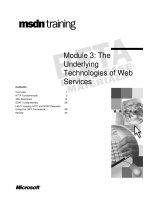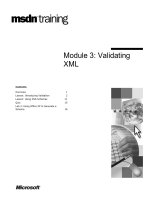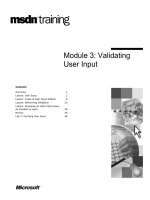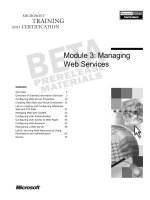Tài liệu Module 3: Characteristics of Information docx
Bạn đang xem bản rút gọn của tài liệu. Xem và tải ngay bản đầy đủ của tài liệu tại đây (292.46 KB, 26 trang )
Module 3: Characteristics of
Information
Module 1: Course
Overview
Module 4: Gathering
Information
Module 5: Analyzing
Information: Use Cases
and Usage Scenarios
Module 6: Analyzing
Information: Rationalizing
Information
Module 7: Presenting
Information
Gathering and Analyzing
Business Requirements
Module 2: Identifying
Business Processes,
Challenges, and Vision
Module 3:
Characteristics of
Information
Categories of
Information
Sources of
Information
Perspectives of
Information
Review
Module 3:
Characteristics of
Information
Module 3: Characteristics of Information 57
!
!!
!
Overview
"
Categories of Information
"
Sources of Information
"
Perspectives of Information
"
Review
In this module...
In this module...
After you have identified business processes and determined the business
challenge and vision statement, you can begin a focused process of gathering
information. From the outset, you need to be aware of the different types and
characteristics of information to ensure that you gather the appropriate
information. The purpose of this module is to introduce you to the different
ways you can think about the information you need to gather about a business
challenge. By taking a broad view of information, you can increase your
chances of gathering all of the input you need to make an effective analysis.
In this module, you will learn about four categories of information that help to
group information and to provide direction on the types of information that you
should collect for the business challenge. Next, you will learn about three
sources of information that you can use when gathering information about each
of the four categories. Finally, you will learn about two perspectives on
information that you can use when you are looking at different sources and
categories of information.
After completing this module, you will be able to:
"
Distinguish the four categories of information present in a set of
information.
"
Generate a list, based on the three sources of information, from which to
gather information on a business challenge.
"
Determine what information to look for, based on business and user
perspectives, when investigating a business challenge.
Slide Objective
To provide an overview of
the module topics and
objectives.
58 Module 3: Characteristics of Information
!
!!
! Categories of Information
"
Business
"
Applications
"
Information
"
Technology
"
Activity 3.1: Identifying Categories of
Information
In this section...
In this section...
The four categories of information that you will learn about in this section are
part of the enterprise architecture model. An enterprise architecture is a
representation of a business, or dynamic system, at a single point in time. The
enterprise architecture for a business aligns information technology groups and
processes with the goals of a business.
A complete review of an enterprise architecture model is beyond the scope of
this course. Instead, you will use four descriptive categories from an enterprise
architecture model to guide and classify the information you gather about a
business. The four categories you will learn about in this section are business,
applications, information, and technology.
In Activity 3.1, you will take information from the case study, break it down,
and assign it to one of the four categories.
Slide Objective
To provide an overview of
the section.
Module 3: Characteristics of Information 59
Business
"
Provides the reasons why a user performs a task
"
Information from the business category can include:
$
Goals and objectives
$
Organizational structure
$
Key business processes and activities
$
Relationships with customers and suppliers
$
Products and services
$
Relationship of all these elements
It is as important to gather information that explains why an individual does a
task as it is to know the details of a task. Each task should contribute to the core
processes of the business in one way or another.
As you gather information about a user’s tasks, determine the business reasons
for each task. An activity could possibly continue even after changes in the
business processes make it irrelevant. A new solution would not need to include
the irrelevant activity.
Information from the business category describes how the business works. It
describes the functions and the cross-functional activities that an organization
performs. Information from this category also describes the enterprise’s high-
level goals and objectives, products and services, financial structures, integrated
business functions and processes, major organizational structures, and the
interaction of these elements. It includes broad business strategies and plans for
moving the organization from its current state to its future state.
Look beyond obvious information for information about what drives the
business. For example, there may be political reasons, internal and external to
the business, that influence policies and decisions.
Slide Objective
To define the business
category.
Lead-in
Information from this
category indicates how the
business works.
60 Module 3: Characteristics of Information
Application
"
The systems used to perform a task
"
Represent the collection of automated services that
support the business processes
"
Information from the application category helps to:
$
Identify redundancies
$
Identify opportunities for reuse
$
Provide guidelines for new applications and application
models
The application category includes the services and functionality that may cross
organizational boundaries and link users of different skills and functions to
achieve common business objectives.
Information in this application category describes the automated and
nonautomated services that support the business processes. It provides
information on the interaction and interdependencies of the organization’s
application systems.
Automated business services can include complete applications, utilities,
productivity tools, components, and code modules that allow for the analysis of
information or task functionality. It is not unusual to find different groups
within an organization performing similar tasks by using different tools.
Likewise, identical tasks are often repeated multiple times by using different
tools.
As you gather information about processes in the organization, investigate the
different applications used to conduct company activities. These existing
applications or portions of these applications can provide core services for any
new application-based solution. It is more cost effective to reuse than to rebuild
these services. The information you gather will help to refine the business
processes by indicating potential inefficiencies or redundancies.
The application category provides information about the current use of systems
and services. You will also obtain indicators about future directions as you
gather information from resources such as users and business documents.
Slide Objective
To describe the application
category.
Lead-in
Information in the
application category
indicates the function of
automated systems and
how they work together.
Module 3: Characteristics of Information 61
Information
"
Describes what the business needs to know to run its
operations
"
Identifies the origin, ownership, and consumption of
information
"
Describes the key business and data objects and their
relationships
"
Describes interactions between applications and
information
The information category describes what the organization needs to know to run
its business processes and operations.
The category includes standard data models, data management policies, and
descriptions of the patterns of information consumption and production in the
organization.
You can identify the information’s origin, ownership, and consumption.
Tracking its access and use patterns provides the basis for making data
distribution, replication, and partitioning decisions, as well as identifying what
is needed to establish standards and guidelines for replication, repositories, and
data warehousing. Often, the consumers of information are not adequately
questioned to determine not only what information they need, but also what
they do with the information when they have it.
The relationship between key business processes and the information required
to perform these processes helps to set standards and guidelines for creating,
retrieving, updating, and deleting information and data; for sharing critical
documents and data; and for defining security levels and standards for access.
Realize that not all information is centralized or easy to access by each person
or system that needs the information. Often, the information most critical to an
organization resides not only in database servers, but also on the desktop
computers that make up the active working environment of the business.
Slide Objective
To define the information
category.
Lead-in
The information category
provides users and the
business with the
information that they need to
run processes and
operations.
62 Module 3: Characteristics of Information
Technology
"
Represents the components and technologies needed
to build and run the organization’s systems
"
Describes the current infrastructure and operational
environment
"
Links technology to the application and information
categories
"
Describes standard interfaces and models for building
applications
The technology category defines the technical services needed to execute and
support the business mission, including the topologies, development
environments, application programming interfaces (APIs), security, network
services, database management system (DBMS) services, technical
specifications, hardware tiers, operating systems, and more.
This category also provides information on the standards and guidelines that a
business uses for acquiring and deploying workstation and server tools, base
applications, infrastructure services, network connectivity components, and
platforms.
Technology provides the link between applications and information.
Applications are created and based on different technologies. They use
technology to access information, which is stored by using various storage
technologies.
You can use information from the technology category to determine the
standard interfaces, services, and application models to be used in development.
This information can translate into development resources for the project teams,
including component/code libraries, standards documents, and design
guidelines. This information can also provide a basis for an application’s design
goals and constraints.
Slide Objective
To define the technology
category.
Lead-in
Information from this
category includes all of the
hardware, software,
technical support, and
standards and guidelines
needed to achieve the
business mission.
Module 3: Characteristics of Information 63
Information that you gather that is relevant to the technology category will help
you or others in the project team to assess the current technology base for the
enterprise. The specifications and requirements that you ascertain from
information in the business, application, and information categories establish
the constraints for evaluating and adopting new technologies. You can use this
information to assess:
"
Overall functionality and effectiveness.
"
Reliability, as in availability, performance, and security.
"
Flexibility, dependencies, and manageability.
"
Overall efficiency or cost of ownership.
Determining what technologies a business uses is important to improving
current processes and developing a business solution.
64 Module 3: Characteristics of Information
Activity 3.1: Identifying Categories of Information
In this activity, you will work in small groups to analyze the case study and find
examples of a particular category.
After completing this activity, you will be able to:
"
Distinguish the four categories of information present in a set of
information.
Slide Objective
To introduce the activity.









